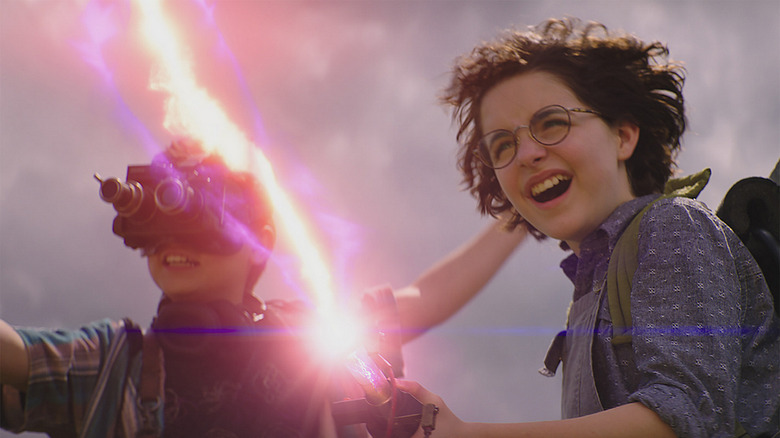
"Ghostbusters: Afterlife" brings a lot of baggage to the big screen this weekend. The "Ghostbusters: Answer the Call" reboot in 2016 didn't deliver what many fans wanted from the franchise (though it's not nearly as bad as some would have you believe), so the new sequel from legacy director Jason Reitman ("Juno," "Up in the Air"), son of "Ghostbusters" director and producer Ivan Reitman, has to make good on over 30 years of anticipation for a new story that picks up where the original films left off. "Ghostbusters 3" has long been demanded but stuck in development hell due to unwilling collaborators keeping the team from getting back together, so it's a miracle that a proper "Ghostbusters" sequel even exists.
"Ghostbusters: Afterlife" is not the sequel that was discussed endlessly over the past few decades. Instead, the movie brings new life to the franchise by imbuing it with the spirit of an Amblin Entertainment movie like "E.T. The Extra-Terrestrial" and "The Goonies," or even their contemporary successor "Super 8." Yes, there's still comedy to be found despite what the dramatic trailers might have you believe, but not exactly in the same sarcastic vein as the sharply scripted and improvised original 1984 film and the 1989 sequel that followed. Unfortunately, it's the slavish dedication to maintaining such a fierce connection to the original franchise in every other way that suffocates what could have been a refreshing new direction for "Ghostbusters: Afterlife," and the movie gets stuck in a nostalgic containment unit because of it.
An Indie Stuck In A Blockbuster Shell
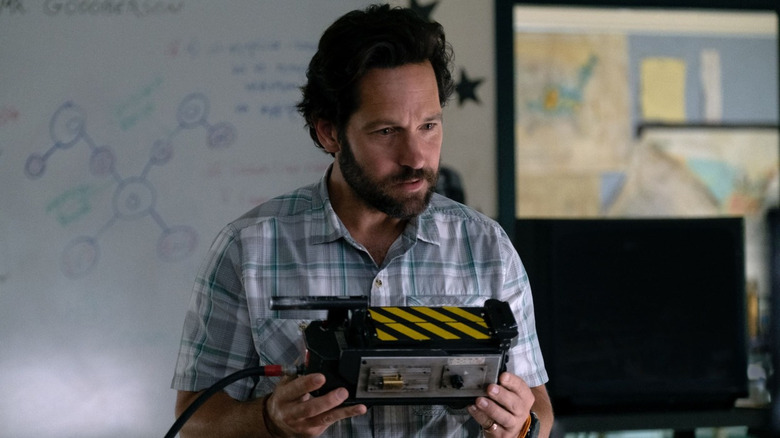
During the promotion of "Ghostbusters: Afterlife," Jason Reitman has frequently recalled the inception of his call to the "Ghostbusters" franchise. Surprisingly, it wasn't a studio mandate or a big paycheck that summoned him to finally follow in the footsteps of his father. Instead, he had the vision of a young girl wearing a proton pack in the middle of a cornfield, and that's when he decided to stop running from his father's blockbuster legacy. The movie was scripted with writer Gil Kenan ("Monster House") and pitched to Ivan Reitman before it ever made it in front of Sony Pictures, and once all the pieces were in place, it was time to see what a new generation of Ghostbusters looks like.
Mckenna Grace ("Annabelle Comes Home," "Gifted") leads "Ghostbusters: Afterlife" as Phoebe, a precocious 12-year-old girl with a penchant for science and technology who suddenly finds herself in the abandoned farmhouse left behind by her recently deceased grandfather. It just so happens that grandfather is Egon Spengler (the late Harold Ramis), one of the original Ghostbusters. But Egon has been estranged from Phoebe's mother Callie (Carrie Coon) for a long time, and she's not shy about any of the resentment that comes from her family being abandoned. She also has a son named Trevor (Finn Wolfhard of "Stranger Things") who is dealing with all the woes of being a teenager forced to live in a dusty rural town during his most formative years.
If this wasn't a "Ghostbusters" movie it would be the perfect set-up for the kind of Sundance-selected indie family dramedy that Jason Reitman could direct in his sleep. But because this is a "Ghostbusters" movie, this carefully crafted and charming dysfunctional family dynamic is thrown smack dab in the middle of a quasi-remake of the original "Ghostbusters." Instead of New York City, we get the small town of Summerville, Oklahoma. And instead of a trio of university professors and a blue collar everyman gathering to start a small supernatural extermination business, we get a couple quirky adolescents, a hormone-fueled teen boy, and a townie teen girl discovering the vintage technology and somehow forgotten legacy of the Ghostbusters and their once celebrated accomplishments. If the meta elements of this narrative weren't already on your radar with Jason Reitman inheriting the "Ghostbusters" franchise, you should be on full alert now.
The Ghost Awakens
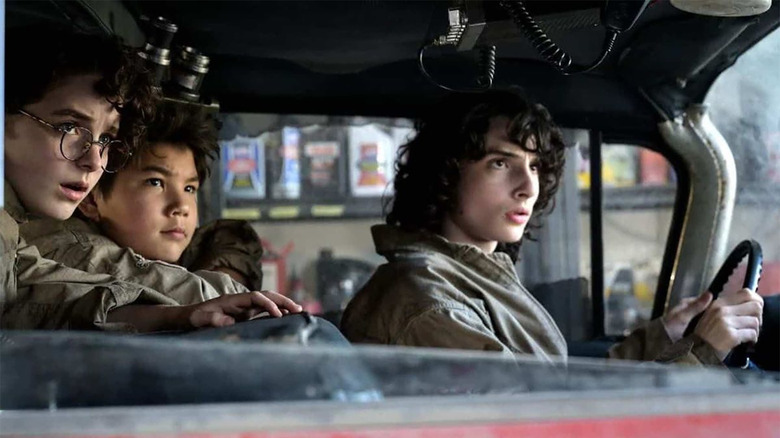
"Ghosbusters: Afterlife" hits many of the same beats as the original "Ghostbusters" much in the same way that "Star Wars: The Force Awakens" treads the familiar territory of "Star Wars: A New Hope." There's a supernatural power that is growing near Summerville, resulting in earthquakes and the appearance of ghosts. Whatever is happening here, Egon Spengler was already on top of it, until his decades of hard work came to an end when a ghost finally got the better of him in the opening sequence of the movie. What he leaves behind is a treasure trove of research and Ghostbusters iconography for his grandchildren to pick up and finish the job. The discovery of the PKE meter, the proton pack, the Ecto-1, and all that comes with it offers up plenty of fun and homages to the franchise in a way that will be very entertaining to longtime fans and young, new audiences alike.
But this is also where the trouble starts to bubble for "Ghostbusters: Afterlife." While Phoebe is established to be a self-sufficient, albeit socially awkward kind of young genius, she has her hand held by the ghost of Egon Spengler. Though the character is smart enough to figure things out on her own, her journey feels like it's cradled too carefully by the unseen character guiding her to everything that she needs to eventually save the world. But then on the other end of the spectrum, it feels like all young characters get a handle on the Ghostbusters technology and lore required without necessarily having time to do the legwork. Part of that comes from the film's breakneck speed, which makes for a breezy watch while maybe glossing over too much of the story.
Then the story starts to follow the same path as the original "Ghostbusters," with Gozer the Gozerian attempting another comeback by way of two terror dogs that possess a pair of unsuspecting humans. In this case, it's Phoebe's mother Callie and summer school teacher, seismologist and grown up Ghostbusters fan Gary Grooberson (Paul Rudd). Because of this, Ghostbusters: Afterlife" speeds through exposition and moves swiftly through key plot points, clearly assuming you've seen the original "Ghostbusters." But the manner in which this new generation of Ghostbusters figures out what's going on feels like it requires tremendous leaps in logic and assumptions. On top of that, there isn't the build-up of supernatural activity that comes to a boil and creates an air of suspense and mystery. Sure, there are genuinely creepy, demented moments and startling scares reminiscent of the first film, but otherwise, everything happens far too quickly to properly get a grip on the proceedings. That includes the first part of the third act, which puts a wild spin on the rootop finale of the original movie, complete with two surprising cameo appearances that no one will see coming, one of which feels completely superfluous.
Crossing The Streams
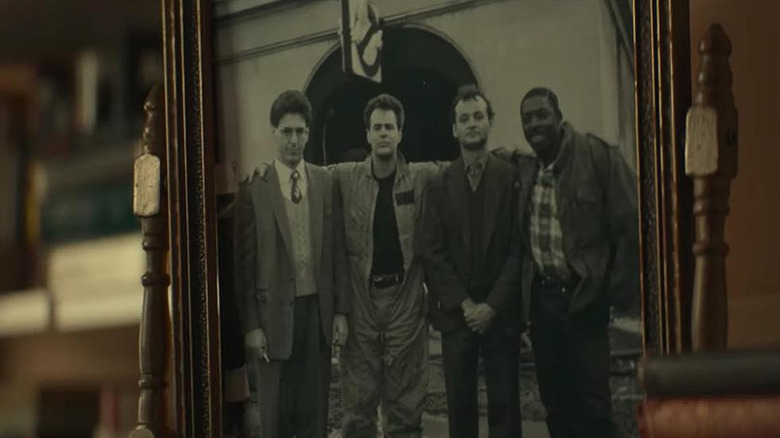
While the first two-thirds of "Ghostbusters: Afterlife" has some issues, it still mostly works. Mckenna Grace does much of the heavy-lifting, giving us a charming, quirky, awkward young hero without overdoing it. She's flat out terrific in this movie, and I think she's going to be a blossoming star as she gets older (her acting credits are already impressive in their own right). Her friend Podcast (Logan Kim) isn't nearly as insufferable as you might assume from his generationally tone-deaf, self-ascribed nickname. In fact, Kim channels the spirit of what you might imagine a young version of Dan Aykroyd's Ray Stantz might have been like. Finn Wolfhard is doing a slightly more angsty version of his persona from "Stranger Things," and Celeste O'Connor makes for a lovely romantic foil who is inevitably thrust into the plot and somehow quickly becomes acquainted with all things Ghostbusters, enough to suddenly wield a proton pack in a key moment. They all somewhat embody the personas of each of the original Ghostbusters in their own way.
Meanwhile, Paul Rudd gives us his best take on the Rick Moranis character from "Ghostbusters," but without being nearly as eccentric and goofy. Rudd is fantastic, especially in his interactions with our young characters. However, the dynamic between he and Carrie Coon feels forced, and when a certain element of the original movie comes into play, that chemistry somehow gets worse, and the comedy that could have been mined from it falls flat and ends up feeling quite contrived.
But it's not all bad. High points include Rob Simonsen's score, which perfectly emulates the original work of Elmer Bernstein by not just recycling familiar orchestral cues, but using them in new ways to craft original riffs that really bring the movie to life. The special effects also work splendidly, including impressive CGI work that never feels like it's polishing the rough-around-the-edges style of the original movie too much. There are even some surprising practical effects that work magnificently. The Ecto-1 ghost chase and the Mini-Pufts scenes are fantastic standout moments too. But they feel removed from what actually works best in the movie, and that's the family dynamic and emotional core that comes from the new characters. It's almost like two totally different movies are at war with each other, and crossing their streams simply doesn't work.
A Third Act Trapped In The Past
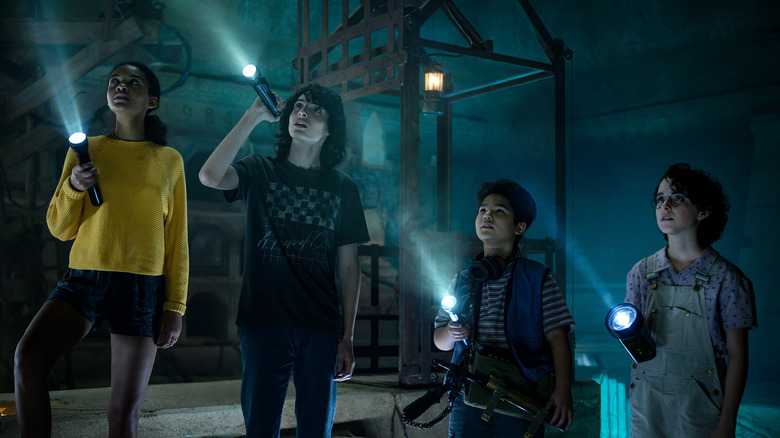
However, nothing flounders more than this film's conclusion. Since discussing the nitty gritty of why the ending doesn't work would require the unveiling of massive spoilers, I'll just say that by the end of the third act, "Ghostbusters: Afterlife" suffocates under the weight of its own forced sentimentality and nostalgia. It's clunky, inorganic, and doesn't feel earned at all. The emotion that's supposed to come from this finale feels misplaced, misguided, and even unsettling. It relies heavily on rectifying a wrongheaded narrative choice involving Egon Spengler's estrangement from the original Ghostbusters (and his family) in the most saccharine and ghoulish way possible. And that's coming from someone who counts the original "Ghostbusters" as one of their favorite movies of all-time and had an appetite for plenty of nostalgia.
I wanted to love "Ghostbusters: Afterlife" so much, and there are parts of it that shine so brightly, but I can't help but think they could have been part of a better movie overall. Perhaps another pass at the script from a different writer outside of "Ghostbusters" royalty would have resulted in something that didn't insist upon itself so much. Nostalgia is fine in limited doses, but the sequel ends up feeling like J.J. Abrams directed "Now That's What I Call Ghostbusters," undoing any of the goodwill established by the film's first two acts. The movie is trapped in the past so much that it might taint any potential future there might be to keep the franchise alive with these new characters.
/Film Rating: 6 out of 10
Read this next: The Best Movies Of 2021 So Far
The post Ghostbusters: Afterlife Review: The Spirit of a Wonderful Amblin Movie Gets Trapped Under Clumsy Nostalgia appeared first on /Film.
from /Film https://ift.tt/3qKyo6c
